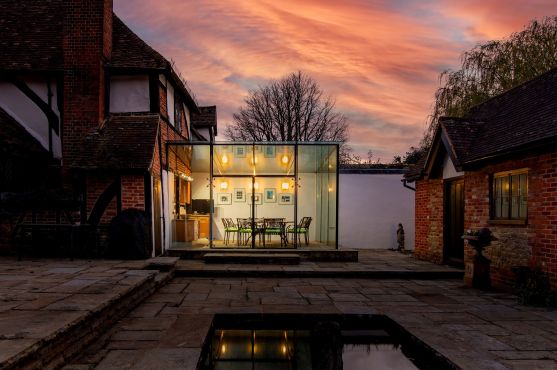
Take 5 ... Homes with extensions
If you’re looking to renovate, or simply wish you were, we’ve picked five properties currently on the market that have got extensions right.


Heatwaves, storms, droughts and wildfires are becoming less of a rarity across the globe, as temperatures continue to climb and weather patterns grow increasingly erratic. These events are the reality of climate change and the need for us to move to a more sustainable future is becoming ever clearer.
In the UK, housing and non-residential buildings account for 17% of total carbon emissions, making the development of sustainable new homes vital, alongside the need to streamline our approach to retrofitting existing stock to reach sustainable standards.
Holding such significance, it’s little surprise that for several years, we’ve dedicated time – and questions – in our annual Housing Futures survey to the topic. In this chapter, we explore the results and look at how sustainability plays a part in households’ home move in 2024.
New build homes feature regularly on the news agenda and are likely to be a major discussion point around the upcoming election. While both main political parties agree that we don’t build enough, – at the time of writing, May ’24 – neither party have been able to produce a manifesto which outlines a concrete plan to build more.
Simple market economics would suggest that if the demand is there, and fully understood, then the supply should start to follow. 30% of those we surveyed stated that they prefer new build homes to second-hand homes, and yet only 9% of property sales in the year to Oct-23 (in England & Wales) were new builds. A statistic which can perhaps be explained by the drastic shortage of stock: the final quarter of 2023 had the lowest number of new home starts in England since the data began in 1978.
‘Sustainability’ is regularly cited as a reason to pick a newly built home, and nearly half of those who said they preferred new builds selected ‘energy efficiency’ as their main reason for this preference.
This is on par with having access to modern amenities, which was also at 48%. Perhaps unsurprisingly, lower bills and upkeep costs are also a major draw to new build homes, with 34% agreeing this was the appeal of a new build.
Talk of sustainable homes has been a constant for many years in our Housing Futures survey, however its prevalence hasn’t picked up as much pace as perhaps expected - or indeed as hoped.
This year, 64% of those surveyed reported that it was either important, or very important, that their next home is already sustainable and environmentally friendly. However, this is in fact a slight fall from 67% in the two previous surveys. Fortunately, only 7% claim that sustainability is either unimportant or very unimportant, with the remainder indifferent as to whether their next home is environmentally friendly or not.
While a home’s sustainability credentials are not a top priority for a third of those surveyed, the more positive news for the environment is that 93% of respondents are interested in how to make their new home greener.
This eagerness doesn’t come with knowledge though; 15% of those who want to make their house greener claim they have ‘no idea of how to do this’; suggesting education and trustworthy advice is lacking.
This year - for the first time - we have delved into the details of how those surveyed would like to make their homes more sustainable, looking at what might be the next eco ‘non-negotiable’.
Insulation stands out as the most well-known method to improve a home’s eco credentials, with 45% of people requiring that their new home be well-insulated. In a similar vein, triple glazed windows are increasingly sought-after by home movers and, according to Alexander Macfarlane in our Building Consultancy team, are a particularly worthwhile feature to keep an eye out for when house hunting. They have their merits both environmentally and efficiency wise, but triple glazed windows do have a long payback period – “they’re an expensive outlay and while they certainly do pay themselves back, it can take several years to break even, so it’s a win if you find a house where the sellers have already made the investment for you”, says Alexander.
“When it comes to ‘greenifying’ your home, there are now so many modifications and technologies available to you, that it can be easy to get drawn in to a house with all the eco bells and whistles. I’d always recommend doing your research on these features before agreeing on a house purchase,” warns Alexander.
“If the home is Listed, then a non-negotiable should be ensuring that the house has Listed Building Consent for the relevant eco updates, such as air source heat pumps or triple glazing. Also, heat pumps can be hugely beneficial, but this is only if they’re installed and used correctly, so make sure you have all the relevant paperwork – including warrantees and even utility bills – so you’re armed with knowledge.
Outside the main house, 16% said that not having an electric charging point would be a dealbreaker, with 66% of respondents looking for an electrical vehicle charging point in their next home.
This is in fact a slight fall against last year – down from 71%. This contrasts with the 141,000 new plug-in vehicle (PiV) licences that were issued in the first three quarters of 2023, up 29% against the same period in 2022.
Perhaps signalling that public EV charging points are becoming more accessible.
However, for those who prefer new builds, having their own charging point is more of a priority. 87% said they’d like an EV charger in their next home. For 35%, this would be a dealbreaker.
The big question when talking about sustainability is often around implementation and how to motivate uptake. While most households happily say they would like a ‘greener’ home, once it comes to the actual purchase, this can often get pushed down the priority list as other more tangible features, such as location or room size, take precedence.
To understand this challenge fully, we asked those who said that a sustainable new home was important to them what they would be most willing to compromise on to have a greener home. Similar to our last survey, the length of commute has remained the top factor that households will be willing to compromise on. This has come down slightly from last year and is likely correlated to many people’s ability to hybrid work and avoid commuting five days-a-week. We know from our survey that 30% of respondents are willing to live further from the office, given that they can work from home some of the time.
Of the 64% of people who said sustainability in their new home was important, after commute length, the top two most cited factors were size of rooms (31%) and location (29%); again, unchanged from last year.
Conversely, safety and pollution are the two least likely to be factors to be conceded, with only 19% and 20%, respectively, willing to compromise on them.
Many people are very aware of climate challenges and are willing to make day-to-day sacrifices to help ease the burden. But it’s clear that major changes are needed in housing for us to see the environmental shift required.
And while there is a certain level of good will, plenty of households will require something more tangible for them to take the eco leap – perhaps unsurprisingly, positively impacting wallets is likely the most effective method.
This financial motivation can come in many forms. A sustainable home can save on energy bills, but the required technology often involves an upfront investment that can take years to recoup. Another option is ‘green mortgages’ where those buying a sustainable home, or who are committing to make their new home more environmentally friendly, are offered a more favourable interest rate. While these mortgages are already available, a wider uptake would likely require the Government to commit to fixing the irregularities of EPCs – to ensure accurate environmental impact is measured – as well as incentivising high street banks to make the rates even more attractive.
However, it’s also hard to ignore that we may be lacking the stock to satisfy the demand for eco-homes – green mortgages or not - with 12% saying there.
Read previous editions of the annual Housing Futures Survey results here.
Contact Matthew Henderson or Alexander Macfarlane.
Download this chapter here.